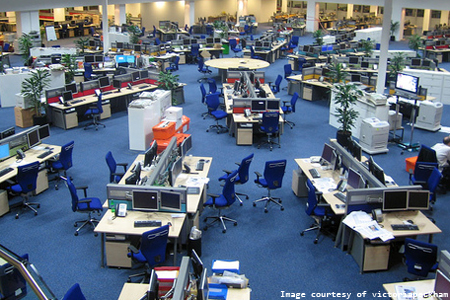Does your research environment stifle your creativity?
Posted on 10 October 2012
Does your research environment stifle your creativity?
 By Alison Williams, SPIRES.
By Alison Williams, SPIRES.
The TV programme Mock the Week has a section where the stand-up comics take it in turn to say "lines you wouldn’t hear in..." So what about a line you wouldn’t hear in a research environment:
“I just adore my open-plan lab!”
Walking along the corridors in my research building the closed doors of the four- or five-person labs display signs like "No Chatting in the Lab". Is chat and buzz antipathetic to good research?
Work done by Space Syntax shows that the more interaction between people, the greater the levels of creative and productive research. For further information on this, listen to Alan Penn speaking about innovation, space and technology at the SPIRES (Supporting People who Investigate Research Environments and Spaces) seminar on physical space, where visibility and chance conversations are linked to research usefulness (visit the SPIRES website for all four parts of the talk). Visibility and informal chance conversations also figure strongly for Wendy Newstetter’s Open Lab (BioMedical Engineering) in creating a community of highly effective researchers. She talks about “opportunistic and intentional learning: eavesdropping as a way to learn” and “serendipitous interaction with the grad student community”. More on this in the SPIRES April conference report and in Wendy's book (Science as Psychology. NY: Cambridge University Press).
My own research into the impact that physical space has on people’s ability to be creative in work has found that our engagement with people, with information and with ideas is a critical factor for our levels of productive creativity. So, the open-plan lab has got to be the best configuration then? Before you start throwing things, let’s look at the other side of the coin. As well as engagement, another key factor to creativity is a person's ability to disengage from other people and from the environment. We need to do this to think, reflect, write, generate ideas, daydream and do all the other solitary activities associated with research.
Each person has, I’ve found, their own unique creative footprint. What I need for different parts of my creative process may not be the same as what you need. Your preferred way of working may send me running for the woods, and mine may drive you nuts. And that is only at one stage of our respective creative processes. When I’m idea-generating, I like to knock ideas about with colleagues, then go into my cave to think them through and give them some shape. Then I need to bring them out again and talk to people again. My creative process is not unlike Resnick’s spiral process of imagine, play, create, share, reflect. Other people I’ve worked with need to generate ideas on their own before they bring them out to develop them. And some people keep their ideas to themselves until they are completely ready to be presented. My findings are that the optimum design of a research environment is one where all the elements of creative footprints are supported.
What is your experience? And would you like to audit your own research environment for its capacity to support and sustain creativity? SPIRES is conducting a research project on this subject, and inviting people to use my Grammar of Creative Workplaces to audit their research environment. You get a report from it, and your data contribute to the database which will allow you to benchmark your space against others in the sector. If you’re interested, get in touch.
Happy open-plan serendipity!
